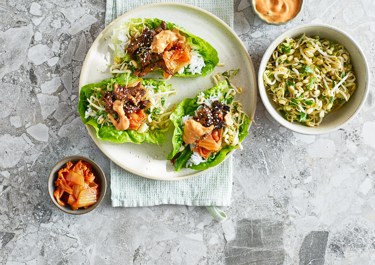
Bulgogi

Instructions
Bulgogi meat
Gochujang cream
Sprout salad
Serve with
Bulgogi
Ingredients
Bulgogi
Sirloin steaks | 500 g |
|---|---|
Pear | 1 |
Yellow onion | 1 |
Garlic cloves | 3 |
Japanese soy sauce | 100 ml |
Powdered sugar | 3 tbsp |
Sesame oil | 2 tbsp |
Rice vinegar or white wine vinegar | 2 tbsp |
Gochujang cream
Green onions | ½ bunch |
|---|---|
Sour cream, 42% | 200 ml |
Gochujang | 2 tbsp |
Sesame oil | 1 tbsp |
Sprout salad
Fresh beans sprouts | approx. 150 g |
|---|---|
Green onions | ½ bunch |
Fresh coriander | 1 bunch |
Toasted sesame seeds | 30 g |
Japanese soy sauce | 1 tbsp |
Lime fruit (unwaxed), finely grated zest and juice | 1 |
Serve with
Jasmine rice | 4 portions |
|---|---|
Lettuce leaves (e.g. romaine or baby gem lettuce) | 16 |
Kimchi | approx. 100 ml |
The origins of bulgogi
This dish is a quintessentially Korean one and can be found on the menus of most local restaurants. Dating back to the Goguryeo era (37 B.C. to 668 A.D.), the dish is part of maekjeok’s evolution story, a preparation technique for skewered (kebab-like) meat. Over time, maekjeok turned into eoryamyeok (a type of stew where marinated beef is soaked in cold water) which, in turn, evolved into neobiani (thin strips of marinated and charbroiled beef) and eventually bulgogi.
The burger variant
Incorporating bulgogi’s big and bold flavours into a burger recipe is an equally mouth-watering meal that has gained popularity in recent years. Simply transform the marinade into a sauce by combining all the ingredients (except for the meat and pear) in a saucepan and reducing it until it coats the back of a spoon. When cooking the burgers, regularly baste the meat with the bulgogi sauce. Topped with the Gochujang cream, kimchi, and lettuce leaves, you may have just found your new favourite burger!
The bulgogi taco variant
Another popular variation is the bulgogi taco. Simply follow the same recipe but swop out the lettuce wraps for tacos. If you prefer a dinner with a kick, exchange the sprout salad for a spicy Korean coleslaw, the perfect complement to the meat’s bold flavours.
Side dish suggestions
Keep it traditional with marinated soybean sprouts (kongnamul muchim), blanched spinach (sigeumchi namul), or a spicy cucumber salad (oi muchim).










